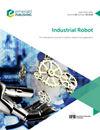变截面索驱动象鼻机器人的设计与研制
IF 2.5
4区 计算机科学
Q3 ENGINEERING, INDUSTRIAL
Industrial Robot-The International Journal of Robotics Research and Application
Pub Date : 2023-02-20
DOI:10.1108/ir-11-2022-0271
引用次数: 0
摘要
在大型设备和高度复杂的密闭工作空间中,维修通常由等截面的蛇形臂机器人进行。但等截面设计导致蛇臂受力集中,工作空间受限。本文的目的是设计一种可变截面象鼻机器人(ETR),通过仿生学原理来解决这些缺点。设计/方法/方法本文提出了一种电缆驱动的ETR,以探索变截面特征对超冗余机器人设计的优势和启示。针对ETR的运动特性,采用控制变量法分析了变截面设计对其最大关节角的影响,选择了结构参数。基于整个象鼻跟随象尖运动的生物学启发,设计了一种求解ETR逆运动学的轨迹跟踪算法。仿真和试验结果表明,所提出的变截面ETR在运动学和受力方面具有独特的优势,可以减少应力集中,提高运动的灵活性。提出了一种适用于受限工作空间的变截面ETR的设计方法,分析了ETR的运动特性,提出了一种有针对性的轨迹控制算法。本文章由计算机程序翻译,如有差异,请以英文原文为准。
Design and development of a cable-driven elephant trunk robot with variable cross-sections
Purpose
In large equipment and highly complex confined workspaces, the maintenance is usually carried out by snake-arm robots with equal cross-sections. However, the equal cross-sectional design results in the snake arm suffering from stress concentration and restricted working space. The purpose of this paper is to design a variable cross-section elephant trunk robot (ETR) that can address these shortcomings through bionic principles.
Design/methodology/approach
This paper proposes a cable-driven ETR to explore the advantages and inspiration of variable cross-section features for hyper-redundant robot design. For the kinematic characteristics, the influence of the variable cross-section design on the maximum joint angle of the ETR is analysed using the control variables method and the structural parameters are selected. Based on the biological inspiration of the whole elephant trunk following the movement of the trunk tip, a trajectory-tracking algorithm is designed to solve the inverse kinematics of the ETR.
Findings
Simulation and test results show the unique advantages of the proposed variable cross-section ETR in kinematics and forces, which can reduce stress concentrations and increase the flexibility of movement.
Originality/value
This paper presents a design method for a variable cross-section ETR for confined working spaces, analyses the kinematic characteristics and develops a targeted trajectory control algorithm.
求助全文
通过发布文献求助,成功后即可免费获取论文全文。
去求助
来源期刊
CiteScore
4.50
自引率
16.70%
发文量
86
审稿时长
5.7 months
期刊介绍:
Industrial Robot publishes peer reviewed research articles, technology reviews and specially commissioned case studies. Each issue includes high quality content covering all aspects of robotic technology, and reflecting the most interesting and strategically important research and development activities from around the world.
The journal’s policy of not publishing work that has only been tested in simulation means that only the very best and most practical research articles are included. This ensures that the material that is published has real relevance and value for commercial manufacturing and research organizations. Industrial Robot''s coverage includes, but is not restricted to:
Automatic assembly
Flexible manufacturing
Programming optimisation
Simulation and offline programming
Service robots
Autonomous robots
Swarm intelligence
Humanoid robots
Prosthetics and exoskeletons
Machine intelligence
Military robots
Underwater and aerial robots
Cooperative robots
Flexible grippers and tactile sensing
Robot vision
Teleoperation
Mobile robots
Search and rescue robots
Robot welding
Collision avoidance
Robotic machining
Surgical robots
Call for Papers 2020
AI for Autonomous Unmanned Systems
Agricultural Robot
Brain-Computer Interfaces for Human-Robot Interaction
Cooperative Robots
Robots for Environmental Monitoring
Rehabilitation Robots
Wearable Robotics/Exoskeletons.

 求助内容:
求助内容: 应助结果提醒方式:
应助结果提醒方式:


